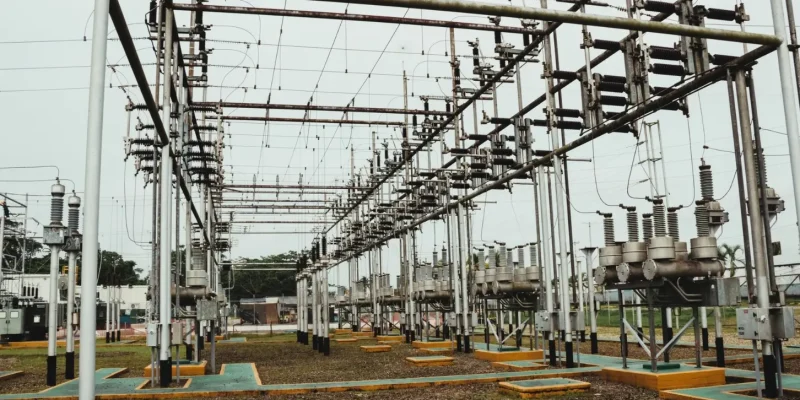A busbar is a critical component in electrical power distribution systems, consisting of a metallic conductor strip or bar that serves as a central hub for collecting and distributing electrical energy. When integrated with circuit breakers, busbars form a robust and safe power distribution network capable of protecting against electrical faults and facilitating system maintenance.
Busbar Function and Role
Busbars play a crucial role in simplifying complex power distributions, making them more affordable and flexible. These metallic conductors, typically made of copper, brass, or aluminum, serve as the backbone of electrical systems by collecting power from incoming feeders and distributing it to outgoing circuits. Their large surface area allows them to handle high current loads efficiently, while their design facilitates easy connections and modifications to the power distribution network. By centralizing electrical junctions, busbars streamline the organization of power systems, reducing the need for multiple individual connections and enhancing overall system reliability.
Benefits of Busbars
Busbars are essential components in modern electrical systems due to their unique advantages over traditional wiring methods. They offer superior efficiency in power distribution by minimizing energy losses during transmission, thanks to their low-impedance design and large cross-sectional area. This efficiency is particularly crucial in high-current applications, where even small losses can result in significant operational costs.
Space optimization is another key benefit of busbars. They reduce the need for numerous cables and wires, allowing for more compact and organized electrical installations. This space-saving feature is especially valuable in industrial settings, data centers, and other facilities where space is at a premium. Additionally, busbars enhance system flexibility and scalability, enabling easy modifications or expansions to accommodate changing power requirements. Their durability, reliability, and ability to withstand high temperatures and electrical stresses make them indispensable in ensuring the safe and efficient operation of complex electrical systems.
Busbar Material Selection: Copper vs. Aluminum
Busbar material selection primarily focuses on copper and aluminum, each offering distinct advantages. Copper busbars exhibit superior electrical conductivity, approximately 58 MS/m compared to aluminum’s 37 MS/m, allowing for higher current-carrying capacity and efficiency. However, aluminum busbars are significantly lighter and more cost-effective, making them attractive for weight-sensitive applications and budget-conscious projects.
Key considerations for material selection include:
- Conductivity: Copper outperforms aluminum, requiring smaller busbars for the same current capacity.
- Weight: Aluminum is about one-third the density of copper, offering advantages in handling and installation.
- Corrosion resistance: Copper naturally resists corrosion better, while aluminum may require additional surface treatments.
- Thermal expansion: Aluminum has a higher coefficient, potentially affecting long-term stability in temperature-variable environments.
- Cost: Aluminum is generally less expensive, though prices fluctuate with market conditions.
The choice between copper and aluminum busbars ultimately depends on specific project requirements, balancing factors such as electrical performance, weight constraints, environmental conditions, and budget considerations.
Busbar Installation Safety
Proper installation and adherence to safety protocols are crucial for ensuring the reliability and protection of busbar systems. When installing busbars, it’s essential to follow manufacturer guidelines and industry standards to prevent electrical hazards and system failures. Key considerations include:
- Insulation: Busbars should be adequately insulated to prevent electrical leakage and arcing. The insulation material must withstand the system’s operating voltage and temperature.
- Overload protection: Implement fuses, circuit breakers, or overcurrent relays to safeguard against overloading. These devices should be sized appropriately for the system’s requirements.
- Labeling: Clearly mark busbars with their respective voltage, phase, and polarity to prevent confusion during installation and maintenance.
- Support structures: Install robust support brackets to handle the busbar’s weight and any mechanical stresses. Ensure proper spacing between supports to maintain structural integrity.
- Personal protective equipment: Workers should wear appropriate PPE, including long-sleeved jackets, gloves, safety shoes, and helmets, when handling and installing busbars.
Regular inspections and maintenance are vital to ensure the continued safe operation of busbar systems, including cleaning, checking insulation for damage, and replacing worn components.
Applications of Busbars
Busbars find extensive applications across various sectors due to their efficiency in power distribution. They are commonly used in electrical switchyards for high voltage equipment, battery banks for low voltage systems, and data centers where reliable power distribution is critical. Industrial settings, such as factories and manufacturing plants, rely heavily on busbar systems for their robust power distribution capabilities. Additionally, these metallic conductors play a vital role in:
- Power generation facilities
- Renewable energy systems, including solar and wind farms
- Commercial buildings and shopping centers
- Telecommunications infrastructure
- Transportation hubs like airports and train stations
The versatility and scalability of busbar systems make them an ideal choice for projects ranging from small-scale residential applications to large industrial complexes, ensuring efficient and safe electrical power distribution across diverse environments.
MCB Busbar Size Chart
MCB busbar sizes vary depending on the current-carrying capacity required for the electrical system. Standard busbar sizes typically range from 20×6 mm to 100×10 mm. Here’s a concise overview of common busbar sizes and their corresponding current capacities:
- 20×6 mm and 20×10 mm: Suitable for lower amperage applications
- 30×10 mm and 40×10 mm: Medium capacity busbars
- 63×10 mm, 80×10 mm, and 100×10 mm: Higher capacity busbars
For higher power applications, busbar sizes can extend up to:
- 630, 800, 1000, 1250, 1600, 2000, 2500, 3200, 4000, 5000, and 6300 amps
When selecting a busbar size, consider factors such as the required ampacity, ambient temperature, and material (copper or aluminum). For precise sizing, consult manufacturer-provided ampacity tables or use busbar size calculators that account for specific installation conditions and safety factors.
Commercial and Residential Applications
Busbars play a crucial role in both commercial buildings and households, offering efficient power distribution solutions tailored to different scales of electrical needs. In commercial settings, busbars are extensively used to manage high-power demands across multiple floors and areas, simplifying complex wiring systems and ensuring consistent power supply throughout the building. They are particularly valuable in office complexes, retail spaces, and large residential buildings where centralized power distribution is necessary.
For households, while less common, busbars are finding increasing applications in modern electrical systems. They are used in home distribution panels, battery banks, and electric vehicle (EV) charging stations, where space efficiency and safety are paramount. In both commercial and residential applications, busbars offer several advantages:
- Enhanced reliability and reduced power loss due to their low-resistance design
- Improved safety by minimizing complex wiring and potential overheating points
- Space efficiency, particularly beneficial in urban environments with limited space
- Easier system expansion and maintenance, allowing for future upgrades without major rewiring
- Cost-effectiveness in the long term, despite potentially higher initial costs, due to reduced maintenance and improved efficiency
Conclusion
Busbars are the unsung heroes of commercial electrical distribution, providing safe, efficient, and flexible power distribution solutions for large buildings. While they may be hidden behind panels and in electrical rooms, their role in keeping our commercial spaces powered is invaluable. Remember: All electrical installation and maintenance work should be performed by qualified professionals. The complexity and high-current nature of busbar systems make professional expertise essential for safety and reliability.


